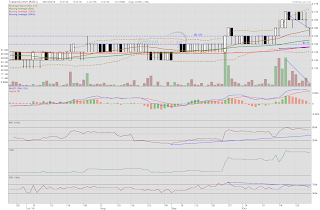Saizen REIT's 1Q FY2011 results did not disappoint. Here are the important points:
1. Gross revenue improved quarter on quarter from S$15,536,000 to S$16,274,000 or a gain of 4.75%. This is largely due to a strengthening JPY against the S$.
2. Net property income (NPI) improved quarter on quarter from S$10,205,000 to S$11,389,000 or a gain of 11.6%! This is due largely to a reduction in property operating expenses.
3. Taking away fees and expenses shows net income from operations improved quarter on quarter from S$4,998,000 to S$6,012,000 or a gain of 20.29%!
Loan amortisation will reduce funds used in interest payment for the REIT, going forward. This would translate to more funds available for distribution to unitholders in future, everything else remaining constant. There was also a one-off expense of JPY14,976,000 which was incurred due to the refinancing of GK Choan's loan. This is non-recurring. We could, therefore, expect the distributable income for 2Q FY2011 and subsequent quarters to be higher.
Everything else remaining constant, I estimate the distributable income for 2Q FY2011 to be JPY 220,000,000 or 7.4% higher than 1Q FY2011. Total distributable income for 1H FY2011 is, therefore, estimated to be JPY 424,943,000. Number of units in issue now at 1,111,003,000. DPU estimated at JPY 0.38. Based on the rate of S$1 = JPY63.3, it means a DPU of 0.6c in March 2011.
Update on YK Shintoku loan
To-date, YK Shintoku has divested a total of 16 properties (5 properties in FY2010, 5 properties in 1Q FY2011 and 6 properties in October and November 2010) as part a deleveraging plan implemented to reduce the absolute amount of the loan of YK Shintoku and the leverage of the corresponding property portfolio, so as to facilitate refinancing efforts.
The loan of YK Shintoku has been reduced from JPY 7.1 billion (S$111.6 million1) as at 30 June 2010 to about JPY 5.6 billion (S$88.1 million) as at the date hereof. Taking into account applicable cash reserves of JPY 0.6 billion (S$9.4 million) maintained by YK Shintoku under the loan agreement, the net outstanding loan of YK Shintoku amounts to approximately JPY 5.0 billion (S$78.6 million). Several divestments of YK Shintoku’s properties are expected in the coming months to reduce the loan amount further.
The amount of S$14.9 million, or approximately JPY 0.9 billion, of warrant proceeds received as at 9 November 2010, have yet to be deployed. Saizen REIT has 328,082,705 warrants which are outstanding and could potentially result in S$29.5 million, or approximately JPY 1.9 billion, of further warrant proceeds being raised1. These warrant proceeds may be applied towards the refinancing of the loan of YK Shintoku (if such refinancing is possible). Saizen REIT also has an aggregate of approximately JPY 12.0 billion (S$188.7 million) of unencumbered properties which can be used as collateral for new loans.
Update on next distribution
Property operations are expected to remain stable, generating steady cash flow to enable Saizen REIT to continue paying out semi-annual distributions. The next distribution payment is expected to take place in March 2011 in respect of distributable cash accumulated in the six months financial period ending 31 December 2010.
Results announcement here.
Related post:
Saizen REIT: AGM on 19 Oct 10.

























































